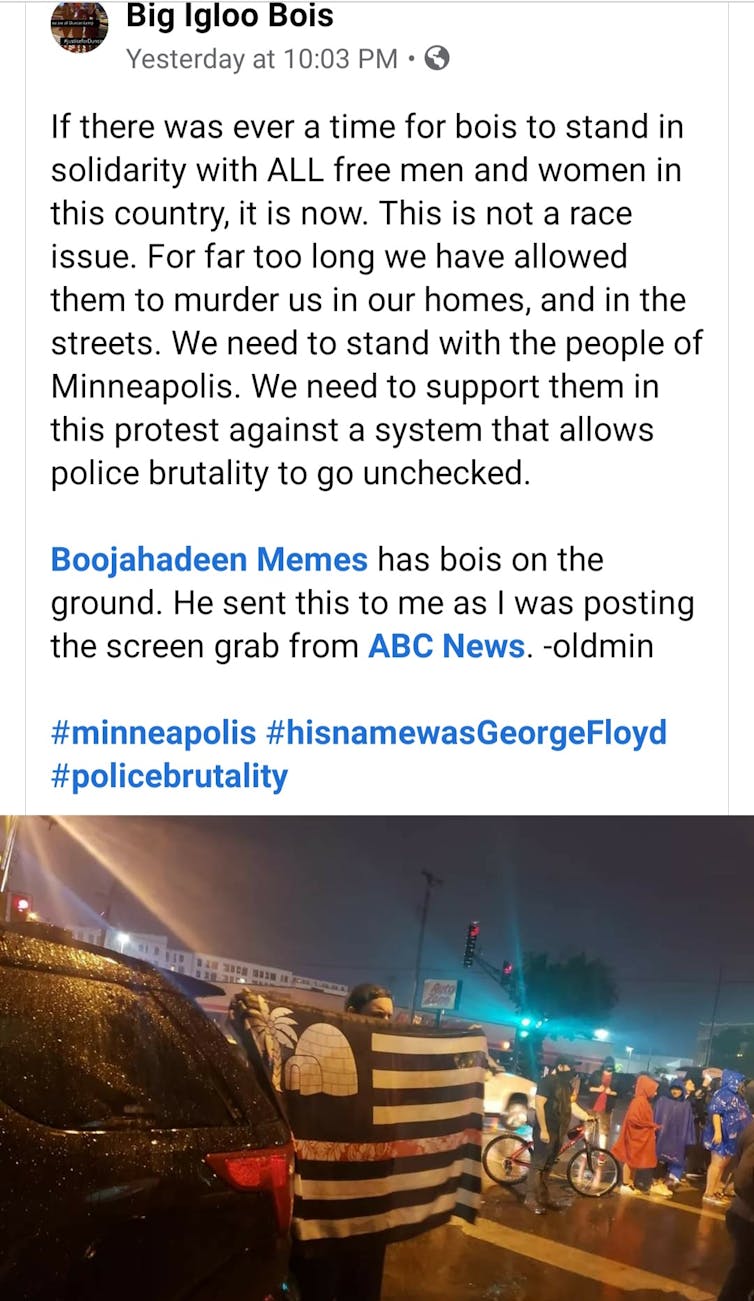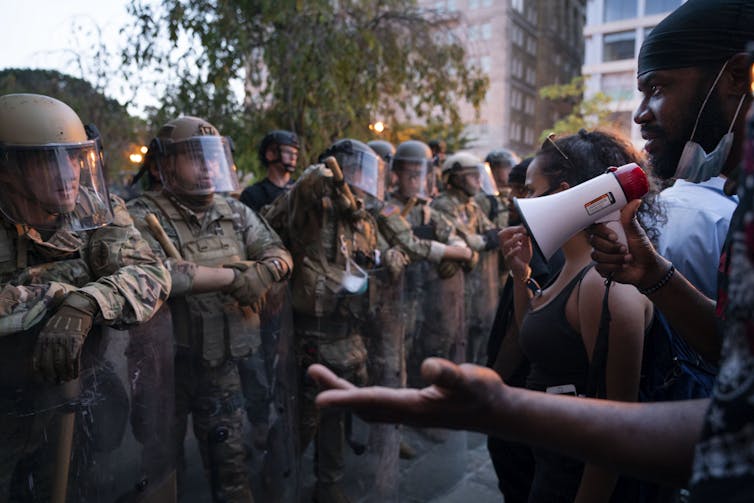Militias evaluate beliefs, action as president threatens soldiers in the streets
- Written by Amy Cooter, Senior Lecturer in Sociology, Vanderbilt University
So-called “militias” and “patriot groups” have different beliefs and viewpoints, but most of these citizen-focused organizations share a concern about government infringement on individual liberties.
In the wake of George Floyd’s death while in police custody[1], citizens are protesting in American streets[2] against police violence. Many protesters are facing off against well-armed officers[3] and National Guard troops, with President Donald Trump threatening to send in federal troops[4].
That puts these groups in a curious position.
Their public activity has long championed the importance of individual constitutional rights[5], and they believe in the right to use armed resistance against government overreach.
But many of these groups’ members have also been supporters of the president[6], who is now speaking openly[7] of taking the sort of far-reaching government action these groups have long warned against.
 Members of the military wearing U.S. Army Special Forces insignia block protesters near Lafayette Park and the White House on June 3, 2020.
Drew Angerer/Getty Images[8]
Members of the military wearing U.S. Army Special Forces insignia block protesters near Lafayette Park and the White House on June 3, 2020.
Drew Angerer/Getty Images[8]
A unique perspective on the militias
My research and analysis[9] of militia groups is based on much more than online posts. I spent three years embedded with the militias in Michigan, doing interviews and ethnographic research, and continue to observe and directly ask members about their motivations for different actions.
In the past, I have seen groups like this oppose police brutality, but usually abstractly or by objecting to violent, individual officers – so-called “bad apples” – rather than systemic racism. They say they are law-abiding citizens and don’t typically think about police violence as something likely to affect them personally.
This is the first time I have seen public Facebook pages for several right-wing organizations openly encouraging[10] members to support black protesters, including calls to travel long distances[11] to Minneapolis to participate in person.
 A post from the ‘Big Igloo Bois’ Facebook page calls for supporters to travel to Minneapolis to join the protests against police violence.
Screenshot from Facebook
A post from the ‘Big Igloo Bois’ Facebook page calls for supporters to travel to Minneapolis to join the protests against police violence.
Screenshot from Facebook
There used to be two kinds
Militia researchers tend to see militia groups as one of two types, based on a distinction identified by historian Robert Churchill[12]. Roughly nine in 10 groups are what he calls Constitutionalist[13], taking a literal interpretation of the Constitution and saying they want to be prepared to defend themselves against the government, should that government become tyrannical.
The remaining 10% of groups he calls Millenarian[14] – a reference to their belief in a range of conspiracy theories including fears of global catastrophe during “Y2K” at the start of this millennium. These groups, influenced by a more threatening view of the world, are more likely to engage in violence and to seek out conflict[15].
In recent months, some militia groups have begun to identify with a different category, one focused on what they call “the boogaloo,” some hoped-for pivotal moment of government overreach where citizens will engage in organized resistance and possibly revolution to take power away from the government.
These people, mostly men, are armed, often dress in Hawaiian shirts and span a broad spectrum of ideas, ranging from a general interest in firearms to openly advocating for civil war[16].
Militia groups don’t typically include race in their overt ideology, but some white supremacist groups have also adopted the “boogaloo” outlook and sometimes attend the same rallies as they advocate for a race war or an all-white nation[17].
President Trump and the 1807 Insurrection Act
This new focus on “the boogaloo” became clear on June 1, when President Trump indicated he might invoke the 1807 Insurrection Act[18] to use federal military forces against civilians inside the U.S.
That threat would seem to line up very closely with what Constitutionalists say they fear – a forceful expansion of government power against its people. But most militia groups have been silent. To date, only a few have made any sort of public statement.
I’ve been asking movement leaders what is going on behind the scenes and have started a survey of some of the larger groups’ members to try to understand this apparent contradiction. The groups are actively discussing among themselves what to do, in comments on Facebook groups and other websites.
A new divide
Some militia members from both Constitutionalist and Millenarian members take a position they call “back the boog” – meaning they believe it is important to capitalize on this moment to resist or punish excessive police power.
One post called attention to Asheville, North Carolina police destroying a volunteer-run medical station[19] for treating injured protesters. The poster suggested distracting police by having militia members “Set up fake medical supplies […] have bottles filled with flammable liquids and other solvents that react … watch as hilarity ensues.”
Some may want to go farther, to incite violence or even start a civil war[20]. Another post tried to stir people into actively attacking police, saying “If anybody really wants to boog rather than larp, let me know.” But this is not the majority outlook in the public postings.
Others “back the blue,” generally supporting the police and objecting to riots and looting as destructive of the American dream of working hard and being free to enjoy the rewards of that labor. They also imagine their livelihoods or personal safety at risk from looters.
 What constitutes insurrection?
Drew Angerer/Getty Images[21]
What constitutes insurrection?
Drew Angerer/Getty Images[21]
Concerned about self-contradiction
Both factions, especially those who “back the blue,” report believing that the damage to property is being coordinated by antifa, a loose-knit antifascist group that encourages people to oppose, sometimes violently, white supremacist demonstrations. There is little evidence to support that claim[22].
However, many militia members have long believed that antifa is an organized terrorist organization that threatens the First Amendment through frequent violence to suppress public speech they disagree with. This belief has likely been fostered by social media bots[23] possibly run by overt white supremacists and, most recently, the president himself[24].
As a result, these followers tell me they worry that open criticism of the president would amount to supporting antifa.
One leader in the movement told me that the “back the blue” faction believes military action to suppress a domestic coup would be a legitimate use of the Insurrection Act. But they also believe that using the act to suppress completely peaceful protesters would be a clear government overreach, because then that power could be directed against anyone. This leader told me military force against protesters “is not acceptable, even if it seems necessary at this moment, because tomorrow, WE will be the protesters, the dissidents.”
He said there is no agreement across groups on how to categorize the range of actions on the spectrum between coup and peaceful protest – for instance, whether a riot qualifies as an insurrection that could justify the use of federal troops.
Putting race aside?
Both groups’ discussions tend to ignore the fact that the Insurrection Act has historically been used specifically to quell black people fighting for justice[25]. “Back the boog” affiliates generally insist that race does not matter, and that police violence is a danger to all citizens.
“Back the blue” believers do not address race overtly. However, as part of blaming antifa for violence, they sometimes seem to imply that black people are unwittingly drawn into looting and rioting. Those comments reflect racist stereotypes of black people as inherently less intelligent[26] and prone to committing crimes.
There is no monolithic militia with a single ideological perspective, and groups are still figuring out their own responses to these ongoing events. Dismissing their current silence as merely hypocritical or racist[27] misses nuance that will be crucial for understanding potential threats and other outcomes from this shift.
References
- ^ George Floyd’s death while in police custody (www.usatoday.com)
- ^ protesting in American streets (theconversation.com)
- ^ well-armed officers (www.nytimes.com)
- ^ send in federal troops (www.nbcnews.com)
- ^ importance of individual constitutional rights (www.routledge.com)
- ^ supporters of the president (nymag.com)
- ^ speaking openly (www.nytimes.com)
- ^ Drew Angerer/Getty Images (www.gettyimages.com)
- ^ research and analysis (deepblue.lib.umich.edu)
- ^ openly encouraging (www.facebook.com)
- ^ calls to travel long distances (www.cnn.com)
- ^ distinction identified by historian Robert Churchill (www.press.umich.edu)
- ^ Roughly nine in 10 groups are what he calls Constitutionalist (www.michiganadvance.com)
- ^ Millenarian (www.britannica.com)
- ^ engage in violence and to seek out conflict (reason.com)
- ^ openly advocating for civil war (www.middlebury.edu)
- ^ race war or an all-white nation (www.adl.org)
- ^ 1807 Insurrection Act (www.ajc.com)
- ^ Asheville, North Carolina police destroying a volunteer-run medical station (www.usatoday.com)
- ^ to incite violence or even start a civil war (www.cnn.com)
- ^ Drew Angerer/Getty Images (www.gettyimages.com)
- ^ little evidence to support that claim (www.businessinsider.com)
- ^ social media bots (www.nbcnews.com)
- ^ president himself (abcnews.go.com)
- ^ quell black people fighting for justice (abcnews.go.com)
- ^ racist stereotypes of black people as inherently less intelligent (www.opportunityagenda.org)
- ^ racist (www.10tv.com)
Authors: Amy Cooter, Senior Lecturer in Sociology, Vanderbilt University

